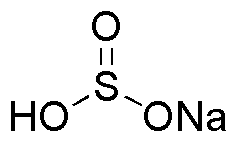Sodium bisulfite is widely utilized in research focused on:
- Food Preservation: Commonly used as a preservative in the food industry to prevent spoilage and maintain freshness, especially in dried fruits and wines.
- Water Treatment: Acts as a reducing agent in water treatment processes, helping to remove chlorine and other harmful substances, making water safer for consumption.
- Photography: Employed in photographic processing to stabilize and preserve images by preventing oxidation of the developing agents.
- Chemical Synthesis: Serves as a versatile reagent in organic chemistry for synthesizing various compounds, including sulfonates and other sulfur-containing chemicals.
- Pharmaceuticals: Used in the pharmaceutical industry as an antioxidant and stabilizer in drug formulations, enhancing the shelf-life and efficacy of medications.
General Information
Properties
Safety and Regulations
Applications
Sodium bisulfite is widely utilized in research focused on:
- Food Preservation: Commonly used as a preservative in the food industry to prevent spoilage and maintain freshness, especially in dried fruits and wines.
- Water Treatment: Acts as a reducing agent in water treatment processes, helping to remove chlorine and other harmful substances, making water safer for consumption.
- Photography: Employed in photographic processing to stabilize and preserve images by preventing oxidation of the developing agents.
- Chemical Synthesis: Serves as a versatile reagent in organic chemistry for synthesizing various compounds, including sulfonates and other sulfur-containing chemicals.
- Pharmaceuticals: Used in the pharmaceutical industry as an antioxidant and stabilizer in drug formulations, enhancing the shelf-life and efficacy of medications.
Documents
Safety Data Sheets (SDS)
The SDS provides comprehensive safety information on handling, storage, and disposal of the product.
Product Specification (PS)
The PS provides a comprehensive breakdown of the product’s properties, including chemical composition, physical state, purity, and storage requirements. It also details acceptable quality ranges and the product's intended applications.
Certificates of Analysis (COA)
Search for Certificates of Analysis (COA) by entering the products Lot Number. Lot and Batch Numbers can be found on a product’s label following the words ‘Lot’ or ‘Batch’.
*Catalog Number
*Lot Number
Certificates Of Origin (COO)
This COO confirms the country where the product was manufactured, and also details the materials and components used in it and whether it is derived from natural, synthetic, or other specific sources. This certificate may be required for customs, trade, and regulatory compliance.
*Catalog Number
*Lot Number
Safety Data Sheets (SDS)
The SDS provides comprehensive safety information on handling, storage, and disposal of the product.
DownloadProduct Specification (PS)
The PS provides a comprehensive breakdown of the product’s properties, including chemical composition, physical state, purity, and storage requirements. It also details acceptable quality ranges and the product's intended applications.
DownloadCertificates of Analysis (COA)
Search for Certificates of Analysis (COA) by entering the products Lot Number. Lot and Batch Numbers can be found on a product’s label following the words ‘Lot’ or ‘Batch’.
*Catalog Number
*Lot Number
Certificates Of Origin (COO)
This COO confirms the country where the product was manufactured, and also details the materials and components used in it and whether it is derived from natural, synthetic, or other specific sources. This certificate may be required for customs, trade, and regulatory compliance.


